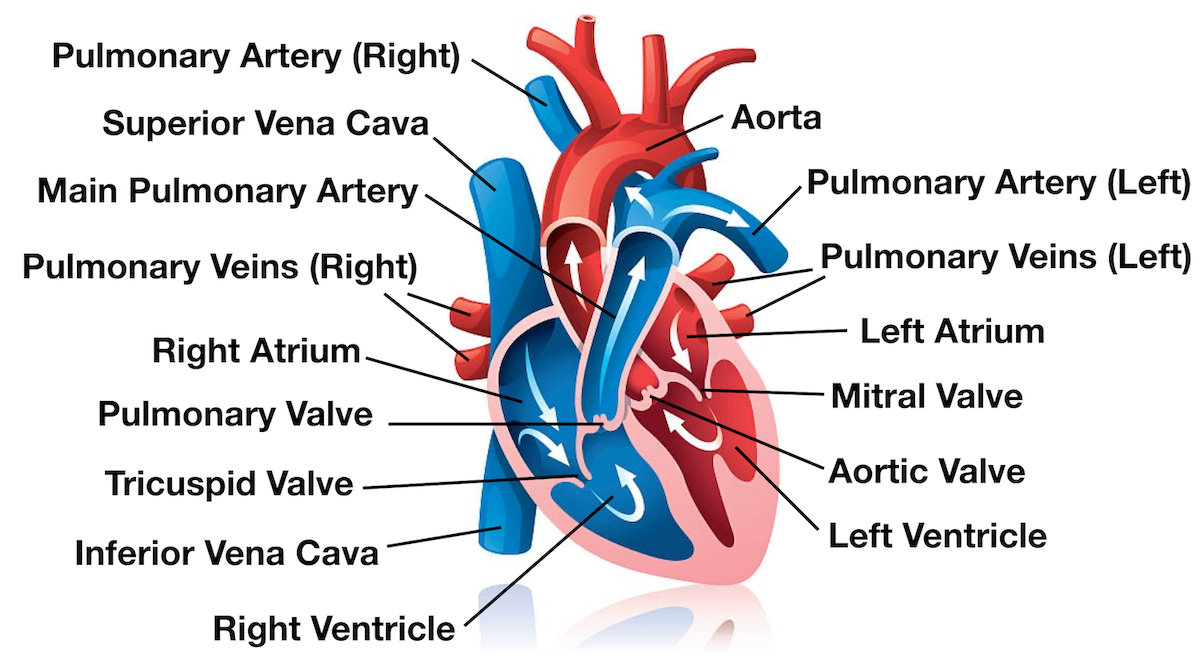In doing so the blood travels through the tricuspid valve located between the. Blood flows through a network of vessels called the circulatory system.
The right ventricle pumps the blood through the pulmonary semilunar valve.

. During diastole when the heart is relaxed and filling with blood the deoxygenated blood from the right atrium will flow to the right ventricle. De-oxygenated blood reaches from the body to the upper chamber on the right the right atrium and it expands. As the right atrium contracts the corresponding lower.
Blood flows through the heart in the following order. Blood enters the right atrium through the superior and inferior venae cavae flows through the right AV tricuspid valve. When blood returns to your heart it flows to your lungs to receive oxygen.
The oxygenated blood from the lungs is received in the left atrium from the. Red blood cell arrives from the inferior vena cava into right atrium before it passes through the tricuspid valve into right ventricle. Blood enters the right atrium goes into the right ventricle.
They are the location of exchange with individual cells and their walls are composed of a single thin layer of endothelial cells which allows for diffusion. The left atrium receives oxygen-rich blood from the lungs via the pulmonary veins. Blood enters the right atrium from the superior and inferior venae cavae and the coronary sinus.
This blood is kept until it may flow into the right ventricle through the tricuspid valve. The deoxygenated blood from the body is received in the right atrium from the vena cava and enters the right ventricle through a tricuspid valve. When the muscular left ventricle contracts the blood is pumped out to the body via aorta.
Veins and carry blood to the heart. The right ventricle pumps the oxygen-depleted blood to the lungs via the pulmonary arteries. The pathway of blood through the heart is as follows.
Venous blood enters the heart through the superior and inferior venae cavae into the right atrium. The blood is oxygenated in the lungs and flows back to the heart in the pulmonary vein into the left atrium and down into the left ventricle where it is pushed up and out of the aorta to the body. The right ventricle then pumps blood into the lungs where the blood gets oxygenated.
The deoxygenated blood that has returned to the heart via the vena cava is held in the right atrium. Then your heart pumps that blood out to the rest of your body and the process begins again. The blood flows from the right atrium into the right ventricle through the open tricuspid valve.
Pulmonary and systemic are the two circuits in the two-circuit system of higher animals with closed circulatory systems. Nearing the end of its journey now. That is the process through which blood navigates in the heart.
It then passes through the pulmonary valve into pulmonary artery before travelling through the lungs and back into the heart this time the left atrium via the pulmonary vein. When a heart contracts and forces blood into the blood vessels there is a certain path that the blood follows through the human body. Enters the right ventricle.
From the atrium they exit the tricuspid valve into the right ventricular. The atrium contracts to squeeze the last of the blood into the ventricle. From the right ventricle it goes through the pulmonary semilunar valves to the pulmonary trunk 4.
Are the smallest blood vessels and connect arterioles and venules. Pathway of blood through the heart 1. Step 3 involves the tricuspid valve.
It enters the pulmonary artery through the semilunar valve and goes to pulmonary circulation. The right ventricle contracts forcing blood into the pulmonary artery through the pulmonary valve. From right atrium it goes through the tricuspid valve to the right ventricle.
1 body 2 inferiorsuperior vena cava 3 right atrium 4 tricuspid valve 5 right ventricle 6 pulmonary arteries 7 lungs 8 pulmonary veins 9 left atrium 10 mitral or bicuspid valve 11 left ventricle 12 aortic valve 13 aorta 14 body. A red blood cell is contained in the Oxygenated blood. Pulmonary vein then brings back the blood from lungs into the left ventricle blood is pumped into the left atrium and out of the heart.
The blood moves through pulmonary circulation and then continues on through systemic circulation.

Blood Flow Of Heart Blood Flow Physiology Path Of Blood Flow Diastole Systole Trace A Drop Of Blood Thr Nursing School Studying Nursing Notes Cardiac Nursing



0 Comments